Ossetians
|
(left to right): Kosta Khetagurov, Gaito Gazdanov, Arsen Kocojty, Grigori Tokaty, Valery Gergiev, Veronika Dudarova, Artur Taymazov | |
| Total population | |
|---|---|
| 720,000 | |
| Regions with significant populations | |
| 528,515[1] | |
| especially in: | 445,310[2] |
(a state with a limited de jure recognition of its independence) | 45,000[3] |
(excluding South Ossetia) | 38,028[4] |
| 59,200[5] | |
| 36,900[5] | |
| 8,170[5] | |
| 5,300[5] | |
| 4,830[6] | |
| 2,340[5] | |
| 2,170[5] | |
| 2,090[5] | |
| 937[5] | |
| 784[5] | |
| 392[5] | |
| 353[5] | |
| 256[7] | |
| 116[8] | |
| n/a[9] | |
| Languages | |
| Ossetian, Russian, Georgian | |
| Religion | |
|
Predominantly † Orthodox Christianity with a minority professing Ossetian Traditional Religion and Islam | |
| Related ethnic groups | |
|
Scythians, Sarmatians, Alans Other Iranian peoples, other neighbouring North Caucasian peoples, and the Jassic people of Hungary. | |
The Ossetians (Ossetian: ир, ирæттæ, ir, irættæ; дигорæ, дигорæнттæ, digoræ, digorænttæ) are an Iranian ethnic group of the Caucasus Mountains, indigenous to the region known as Ossetia.[10][11][12] They speak Ossetic, an Iranian language of the Eastern branch of the Indo-European languages family, with most also fluent in Russian as a second language. The Ossetians are mostly Eastern Orthodox Christian, with a Muslim minority.
The Ossetians mostly populate Ossetia, which is politically divided between North Ossetia–Alania in Russia, and South Ossetia, which since the 2008 South Ossetia war has been de facto independent from Georgia.
Etymology
The Ossetians and Ossetia received their name from the Russians, who adopted the Georgian designations Osi (sing., pl.: Osebi) and Oseti ("the land of Osi"), used since the Middle Ages for the Iranian-speaking population of the Central Caucasus and probably based on the old Alan self-designation "As". As the Ossetians lacked any single inclusive name for themselves in their native language, these terms were accepted by the Ossetians themselves already before their integration into the Russian Empire.[13]
This practice was put into question by the new Ossetian nationalism in the early 1990s, when the dispute between the Ossetian subgroups of Digoron and Iron over the status of the Digoron dialect made the Ossetian intellectuals search for a new inclusive ethnic name. This, combined with the effects of the Georgian-Ossetian conflict, led to the popularization of "Alania", the name of the medieval Sarmatian confederation, to which the Ossetians traced their origin, and inclusion of this name into the official republican title of North Ossetia in 1994.[13]
Subgroups
- Iron in the east and south form a larger group of Ossetians. Irons are divided into several subgroups: Alagirs, Kurtats, Tagaurs, Kudar, Tual, Urstual, Chsan.
- Digoron in the west. Digors live in Digora district, Iraf district and in some settlements in Kabardino-Balkaria and Mozdok district. Digors in Digora district are Christian, while those living in Iraf district are Muslim. They speak Digor dialect, an archaic form of the Ossetian language.
Culture
Mythology
The folk beliefs of the Ossetian people are rooted in their Sarmatian origin and Christian religion, with the pagan gods transcending into Christian saints. The Nart saga serves the basic pagan mythology of the region.[14]
Music
History

Prehistory (Early Alans)
The Ossetians descend from the Alans, a Sarmatian tribe (Scythian subgroup of the Iranian ethnolinguistic group).[15] About AD 200, the Alans were the only branch of the Sarmatians to keep their culture in the face of a Gothic invasion, and the Alans remaining built up a great kingdom between the Don and the Volga, according to Coon, The Races of Europe. Between AD. 350 and 374, the Huns destroyed the Alan kingdom, and a few survive to this day in the Caucasus as the Ossetes.
Middle Ages

In the 8th century a consolidated Alan kingdom, referred to in sources of the period as Alania, emerged in the northern Caucasus Mountains, roughly in the location of the latter-day Circassia and the modern North Ossetia–Alania. At its height, Alania was a centralized monarchy with a strong military force and benefited from the Silk Road.
Forced out of their medieval homeland (south of the River Don in present-day Russia) during Mongol rule, Alans migrated towards and over the Caucasus mountains, where they subsequently would form three ethnographical groups; the Iron, Digoron, and Kudar. The Jassic people were a group that migrated in the 13th century to Hungary.
Modern history
In recent history, the Ossetians participated in Ossetian-Ingush conflict (1991–1992) and Georgian–Ossetian conflicts (1918–1920, early 1990s) and in the 2008 South Ossetia war between Georgia and Russia.
Key events:
- 1774 — The Iranian Afsharid Dynasty starts to disintegrate. North Ossetia becomes part of the Russian Empire[16]
- 1801 — Following the Treaty of Georgievsk and the abjuring of Georgia from Persian suzerainty, the modern-day South Ossetia territory becomes part of the Russian Empire, along with Georgia[17]
- 1922 — Ossetia is divided[18][19] into two parts: North Ossetia remains a part of Russian SFSR, South Ossetia remains a part of Georgian SSR.
- 20 September 1990 – independent Republic of South Ossetia. The republic remained unrecognized, yet it detached itself from Georgia de facto. In the last years of the Soviet Union, ethnic tensions between Ossetians and Georgians in Georgia's former Autonomous Oblast of South Ossetia (abolished in 1990) and between Ossetians and the Ingush in North Ossetia evolved into violent clashes that left several hundreds dead and wounded and created a large tide of refugees on both sides of the border.[20][21]
Language
The Ossetian language belongs to the Iranian branch of the Indo-European language family.
Ossetian is divided into two main dialect groups: Ironian (os. – Ирон) in North and South Ossetia and Digorian (os. – Дыгурон) of western North Ossetia. There are some subdialects in those two: like Tualian, Alagirian, Ksanian, etc. The Ironian dialect is the most widely spoken.
Ossetian is among the remnants of the Scytho-Sarmatian dialect group which was once spoken across Central Asia. Other surviving languages closely related to Ossetian are Yaghnobi,[22] Pashto[22] and Pamiri languages,[22] all spoken more than 2,000 km to the east in Afghanistan, northwestern Pakistan and some parts of Tajikistan.
Religion
The Alans were partially Christianized by Byzantine missionaries in the beginning of the 10th century.[23] Most of the Ossetians became Eastern Orthodox Christians in the 12th–13th centuries under the influence of Georgia.[24][25]
As the time went by, Digor in the west came under Kabardian and Islamic influence. It was through the Kabarday (an East Circassian tribe) that Islam was introduced into the region in the 17th century.[26]
Ossetia became part of the Russian Empire in 1774, which strengthened Orthodox Christianity considerably.
Today, the majority of Ossetians, both from North and South Ossetia, follow Eastern Orthodoxy, although there is a Muslim minority in the North.
Ossetian ethnic religion is still widespread among Ossetians, with rich ritual traditions, sacrificing animals, holy shrines, non-Christian saints, etc. In accordance with the research service «Sreda» there is a highest percentage of followers in North Ossetia among all regions of Russia,[27] while the research ignores the ethnicity of people participated in the polls. There are temples, known as kuvandon in most of the villages.[28] Ætsæg Din is the Ossetian ethnic religion of the Ossetian ethnic religion, emerging since the 1980s.[29]
Demographics
The vast majority of Ossetians live in Russia (according to the Russian Census (2002)):
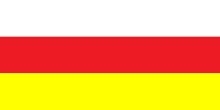 North Ossetia–Alania — 445,300
North Ossetia–Alania — 445,300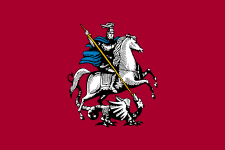 Moscow — 10,500
Moscow — 10,500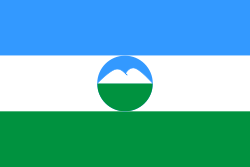 Kabardino-Balkaria — 9,800
Kabardino-Balkaria — 9,800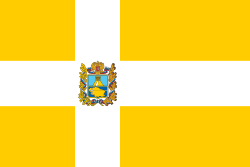 Stavropol Krai — 7,700
Stavropol Krai — 7,700.png) Krasnodar Krai — 4,100
Krasnodar Krai — 4,100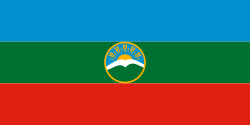 Karachay–Cherkessia — 3,200
Karachay–Cherkessia — 3,200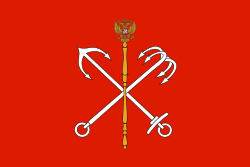 Saint Petersburg — 2,800
Saint Petersburg — 2,800 Rostov Oblast — 2,600
Rostov Oblast — 2,600 Moscow Oblast — 2,400
Moscow Oblast — 2,400
Second-largest population of Ossetians is in South Ossetia.
There is a significant number living in north-central Georgia (Trialeti). A large Ossetian diaspora lives in Turkey, and Ossetians have also settled in Belgium France, Sweden, Syria, the USA (New York City, Florida and California as examples), Canada (Toronto), Australia (Sydney) and other countries all around the world.
Genetics
The Ossetians are a unique ethnic group of the Caucasus, being the only people found on both the north and south slopes of the mountain, also speaking an Indo-European language surrounded by Caucasian ethnolinguistic groups. The Y-haplogroup data indicate that North Ossetians are more similar to other North Caucasian groups, and South Ossetians are more similar to other South Caucasian groups, than to each other. Also, with respect to mtDNA, Ossetians are significantly more similar to Iranian groups than to Caucasian groups. It is thus suggested that there is a common origin of Ossetians from Iran, followed by subsequent male-mediated migrations from their Caucasian neighbours [30][31] However, it is important to bear in mind that, as with other ethnic groups throughout the Caucasus, and despite the mainly Indo-European and Iranic roots of the Ossetians, their genetic make-up is otherwise still relatively heterogeneous as a result of extensive intermarriage with other ethnic groups in the region. In the Medieval, Imperial Russian, Soviet and contemporary periods it has been and is common to find Christian Orthodox Ossetian intermarriage with Georgians, Russians, Armenians, and Pontic Greeks (in Georgia usually divided between Caucasus Greeks and Turkish-speaking Urums), and Muslim Ossetian intermarriage with Meskhetian Turks, Kabardays, Ingushes, Chechens, and other Muslim communities of especially the North Caucasus.
Gallery
-

Ossetian woman in traditional clothes, early years of the 20th century.
-

Ossetian women working (19th century)
-

Ossetian Northern Caucasia dress of the 18th century, Ramonov Vano (19th century)
-

Three Ossetian teachers (19th century)
-

Ossetian girl 1883
-
South Ossetian performers.
-
Ruslan Karaev, professional kickboxer
-
Vladimir Gabulov, Ossetian goalkeeper
-

Gaito Gazdanov, émigré writer
-
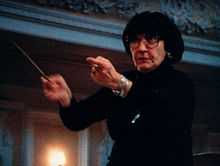
Veronika Dudarova, symphony conductor
See also
- Jassic people
- Iazyges
- Alans
- Sarmatians
- Scythians
- Iron (people)
- Digor (people)
- Iranian peoples
- Ossetians in Turkey
- Ossetians in Trialeti
- Peoples of the Caucasus
References
- ↑ Russian Census 2010: Population by ethnicity (Russian)
- ↑ 2002 Russian census
- ↑ (2007) PCGN Report "Georgia: a toponymic note concerning South Ossetia" (page 3).
- ↑ (2002 census)
- ↑ 5.0 5.1 5.2 5.3 5.4 5.5 5.6 5.7 5.8 5.9 5.10 Joshua Project
- ↑ 2001 Ukrainian census
- ↑
- ↑ 2000 Estonian census
- ↑ Ossetians
- ↑ Bell, Imogen. Eastern Europe, Russia and Central Asia, p. 200.
- ↑ Mirsky, Georgiy I. On Ruins of Empire: Ethnicity and Nationalism in the Former Soviet Union, p. 28.
- ↑ Mastyugina, Tatiana. An Ethnic History of Russia: Pre-revolutionary Times to the Present, p. 80.
- ↑ 13.0 13.1 Shnirelman, Victor (2006). The Politics of a Name: Between Consolidation and Separation in the Northern Caucasus. Acta Slavica Iaponica 23, pp. 37–49.
- ↑ Lora Arys-Djanaïéva "Parlons ossète" (Harmattan, 2004)
- ↑ James Minahan, "One Europe, Many Nations", Published by Greenwood Publishing Group, 2000. pg 518: "The Ossetians, calling themselves Iristi and their homeland Iryston are the most northerly Iranian people. ... They are descended from a division of Sarmatians, the Alans who were pushed out of the Terek River lowlands and in the Caucasus foothills by invading Huns in the 4th century AD.
- ↑
- ↑
- ↑ Svante E. Cornell, Small nations and great powers: a study of ethnopolitical conflict in the Caucasus. Routledge, 2001 ISBN 0-7007-1162-7
- ↑ "South Ossetia – MSN Encarta". Archived from the original on 2009-11-01.
- ↑ http://www.gcsp.ch/e/publications/Issues_Institutions/Int_Organisations/Academic_Articles/Ghebali-Helsinki-3-04.pdf
- ↑ http://www.obiv.org.tr/2005/avrasya/ehatipoglu.pdf
- ↑ 22.0 22.1 22.2 Nicholas Sims-Williams, Eastern Iranian languages, in Encyclopædia Iranica, Online Edition, 2010. "The Modern Eastern Iranian languages are even more numerous and varied. Most of them are classified as North-Eastern: Ossetian; Yaghnobi (which derives from a dialect closely related to Sogdian); the Shughni group (Shughni, Roshani, Khufi, Bartangi, Roshorvi, Sarikoli), with which Yaz-1ghulami (Sokolova 1967) and the now extinct Wanji (J. Payne in Schmitt, p. 420) are closely linked; Ishkashmi, Sanglichi, and Zebaki; Wakhi; Munji and Yidgha; and Pashto."
- ↑ Kuznetsov, Vladimir Alexandrovitch. "Alania and Byzantine". The History of Alania.
- ↑ James Stuart Olson, Nicholas Charles Pappas. An Ethnohistorical dictionary of the Russian and Soviet empires. Greenwood Publishing Group, 1994. p 522.
- ↑ Ronald Wixman. The peoples of the USSR: an ethnographic handbook. M.E. Sharpe, 1984. p 151
- ↑ James Minahan. Miniature empires: a historical dictionary of the newly independent states. Greenwood Publishing Group, 1998. p.211
- ↑ Arena - Atlas of Religions and Nationalities in Russia. Sreda.org
- ↑ http://www.keston.org.uk/_russianreview/edition57/01-roschtin-about-south-alania.htm
- ↑ http://osetins.com/print:page,1,1450-mestnaja-religioznaja-organizacija-tradicionnykh.html
- ↑ http://onlinelibrary.wiley.com/doi/10.1046/j.1529-8817.2004.00131.x/abstract
- ↑ Genetic evidence concerning the origins of South and North Ossetians. by Max Planck Institute for Evolutionary Anthropology, Department of Evolutionary Genetics. Ann Hum Genet. 2004 Nov;68(Pt 6):588-99.
Bibliography
- Nasidze et al., Mitochondrial DNA and Y-Chromosome Variation in the Caucasus, Annals of Human Genetics, Volume 68 Page 205 – May 2004
- Nasidze et al., Genetic Evidence Concerning the Origins of South and North Ossetians (2004)
External links
| ||||||||||||||||||
| ||||||||||||||||||||||||||||||||
| ||||||||||||||||||||||||
| ||||||||||||||||||||||||||||||||||||||||||||||||||||||||||||||||||||||||||




